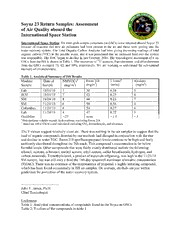
NASA Technical Reports Server (NTRS) 20110008818: Soyuz 23 Return Samples: Assessment of Air Quality Aboard the International Space Station PDF
Preview NASA Technical Reports Server (NTRS) 20110008818: Soyuz 23 Return Samples: Assessment of Air Quality Aboard the International Space Station
Soyuz 23 Return Samples: Assessment of Air Quality aboard the International Space Station International Space Station: Six mini-grab sample containers (m-GSCs) were returned aboard Soyuz 23 because of concerns that new air pollutants had been present in the air and these were getting into the water recovery system. The Total Organic Carbon Analyzer had been giving increasing readings of total organic carbon (TOC) in the potable water, and it was postulated that an increased load into the system was responsible. The TOC began to decline in late October, 2010. The toxicological assessment of 6 m- GSCs from the ISS is shown in Table 1. The recoveries of 13C-acetone, fluorobenzene, and chlorobenzene from the GSCs averaged 73, 82, and 59%, respectively. We are working to understand the sub-optimal recovery of chlorobenzene. Table 1. Analytical Summary of ISS Results Module/ Date of NMVOCsa Freon 218 T Valueb Alcohols Sample Sample (mg/m3) (mg/m3) (units) (mg/m3) Lab 10/14/10 7 50 0.38 5 JEM 10/14/10 7 43 0.25 6 SM 10/14/10 8 44 0.23 7 SM 11/24/10 6 58 0.56 4 Columbus 11/24/10 6 54 0.27 4 Lab 11/24/10 4 47 0.22 3 Guideline <25 none <1.0 <5 a Non-methane volatile organic hydrocarbons, excluding Freon 218 b Based on 180-d SMACs and calculated excluding CO , formaldehyde, and siloxanes. 2 The T-values suggest relatively clean air. There was nothing in the air samples to suggest that the load of organic compounds detected by our methods had changed in conjunction with the rise and decline in water TOC. Freon 218 (perfluoropropane) levels continue to be high and fairly uniformly distributed throughout the ISS stack. This compound’s concentration is far below harmful levels. Other compounds that were fairly evenly distributed include the following: ethanol, acetone, n-butanol, methyl acetate, ethyl acetate, sulfur hexafluoride, hydrogen, and carbon monoxide. Trimethylsilanol, a product of materials offgassing, was high in the 11/24/10 SM sample, but was still only a third the 180-day spacecraft maximum allowable concentration (SMAC). There was no evidence of the reappearance of propenal, a highly irritating compound, which has been found occasionally in ISS air samples. On average, alcohols are just within guidelines for protection of the water recovery system. -------------------------------- John T. James, Ph.D. Chief Toxicologist Enclosures Table 1: Analytical concentrations of compounds found in the Soyuz m-GSCs Table 2: T-values of the compounds in table 1
